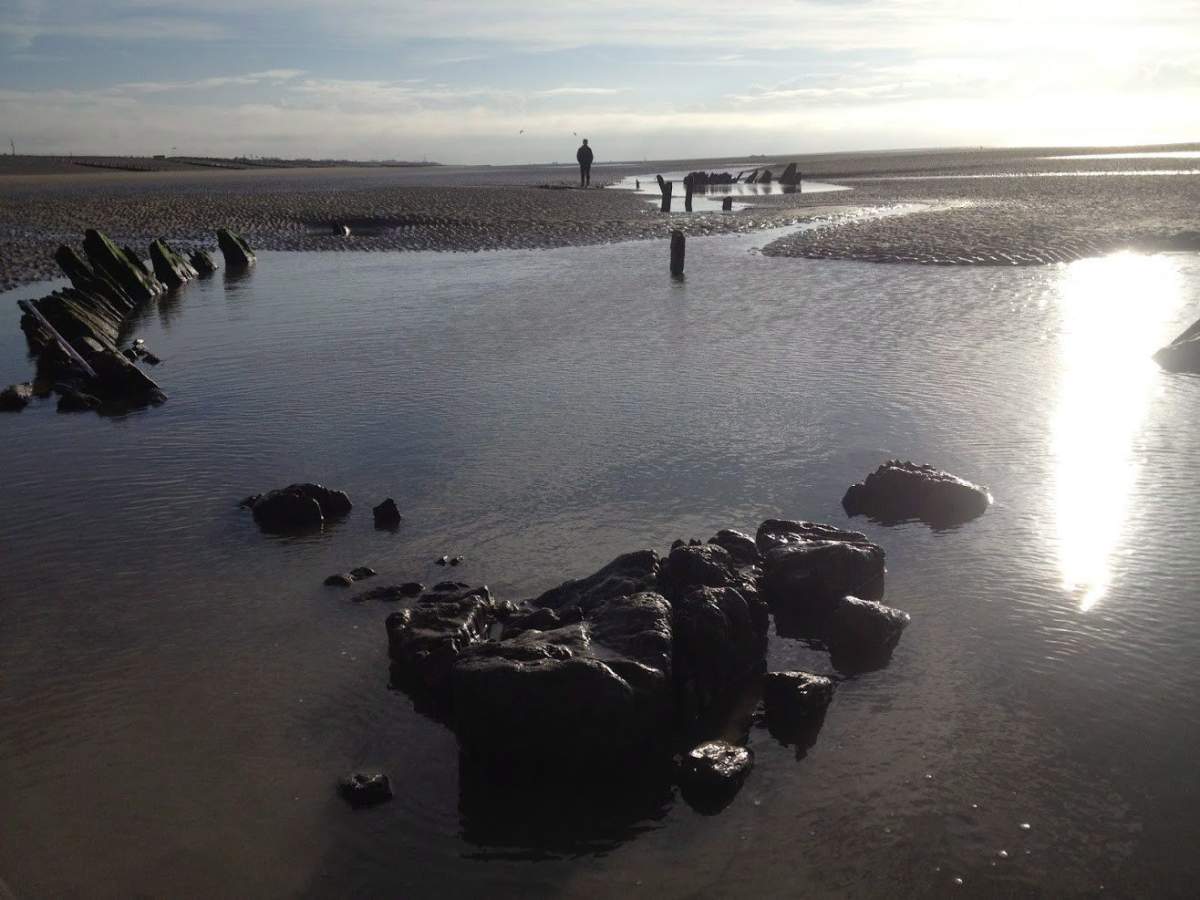Researchers say remnants of a nearly 200-year-old ship washed up on an English beach could be the soggy remains of a Nova Scotian vessel.

The shipwreck was discovered in 2016 by a local woman on the shore of Camber Sands, a popular beach near Rye in the county of East Sussex.
She alerted the British history organization Historic England, who sent researchers to the site to take a look.
“When you turn up there, it’s clearly the shape of a ship: you’ve got the sharp bow, you’ve got the timber sticking up, you’ve got the shape of the stern,” said Joseph Flatman, head of listing programs with Historic England.
“And it’s a big ship – we are talking nearly 50 metres long, and the timbers are very, very heavy, very solidly framed.”
READ MORE: Robot found ‘Holy Grail of shipwrecks,’ with up to $17B in treasure aboard
Flatman said the most interesting part is that it had likely been there – in a prominent spot for tourists and families – for quite some time and was only recently discovered, although the woman reported seeing a stump during previous visits to the location.
He explained that it may have been covered in sand that had washed away with the changing tides.
Analysis of timber from the wreck points to the ship having a North American origin. After searching through documents held by England’s National Record of the Historic Environment, Historic England tentatively linked the wreck to the Avon, a brig-style vessel reportedly built in Nova Scotia in 1843.
The records indicate the ship was reported to have “stranded and drifted alongshore to the east side of Rye Harbour, and received considerable damage” in August 1852 while en route from Le Havre in northwestern France, though NRHE didn’t have any data on the Camber Sands wreck itself.

Get daily National news
The records were also unclear on the origin of the Avon: while it was seemingly built in 1843, records didn’t indicate whether or not the ship was built originally at that time, or if it was a repair of an older vessel, or if it re-used earlier timbers.
Flatman said dendochronology analysis – tree-ring dating – has been inconclusive in linking the wreck to that specific ship, and researchers are conducting further analysis of the timber and records to try to confirm a match.
“I don’t want to say it’s definitely the Avon, because honestly, we don’t know and we may never know,” he said, explaining the vast majority of shipwrecks in England are never definitively identified.
“But the combination of having been built in Nova Scotia, having been built in the 1840s with the heavy timbers … it’s a good match. It’s not a perfect match, but it’s the right sort of size, from the right sort of place, with the right kind of frame.”
He added his organization won’t be able to fully excavate the wreck because of its size and the cost involved, but they intend to collect further timber samples as well as take a deeper look into newspaper archives from that time in an attempt to unravel the mystery.
“If you build the jigsaw puzzle with different bits of data together, hopefully you’ll get a really good picture,” said Flatman.
“There’s more to be told about this site, but we need to spend some more time doing it.”
WATCH: Submarine explores wreck of Russian warship believed to have been sunk in Russo-Japanese War

Roger Marsters, curator of Marine History at the Maritime Museum of the Atlantic in Halifax, said he’s been doing some digging since he heard about the Camber Sands wreck.
He said tracing the ship’s roots are complicated because of its name – some Maritime areas have places and landmarks with “Avon” in their names, including the Avon River in central Nova Scotia and New Avon, a small New Brunswick community.
“There are, perhaps unsurprisingly, a lot of vessels built in Nova Scotia and New Brunswick with that name,” he laughed.
Ship directories held by the Avon River Heritage Society have multiple ships listed by that name, but they are either the wrong type or were built in the wrong year.
Marsters tracked down a British parliamentary report from 1874 indicating that a ship named the Avon was built in Onslow, N.S., in 1843, although he said some of the information in the report may cast doubt as to whether the Camber Sands wreck is the same ship.
He said the report said the Avon was stranded as opposed to wrecked, and also indicated it was re-registered in London in 1852.
“That may have happened before the stranding, or after the stranding,” said Marsters.
“If it happened after, that would suggest the vessel in the U.K. is not the Avon.”
He did specify that the wreck could very well still be the mysterious ship, but researchers will have to figure out when exactly it happened before they could know for sure.
Regardless, Marsters said it’s an interesting mystery that speaks to the ubiquity of Nova Scotia’s long shipbuilding history.
“Whether this vessel is Avon or not, hundreds, and indeed, thousands of vessels built in Nova Scotia were sailing off the coast of the U.K. in the 19th century,” he said.
“I think this is a living reminder of the legacy of that past.”







Comments